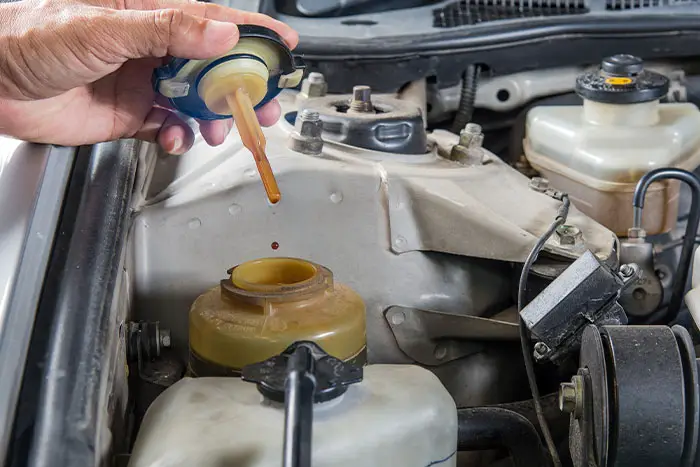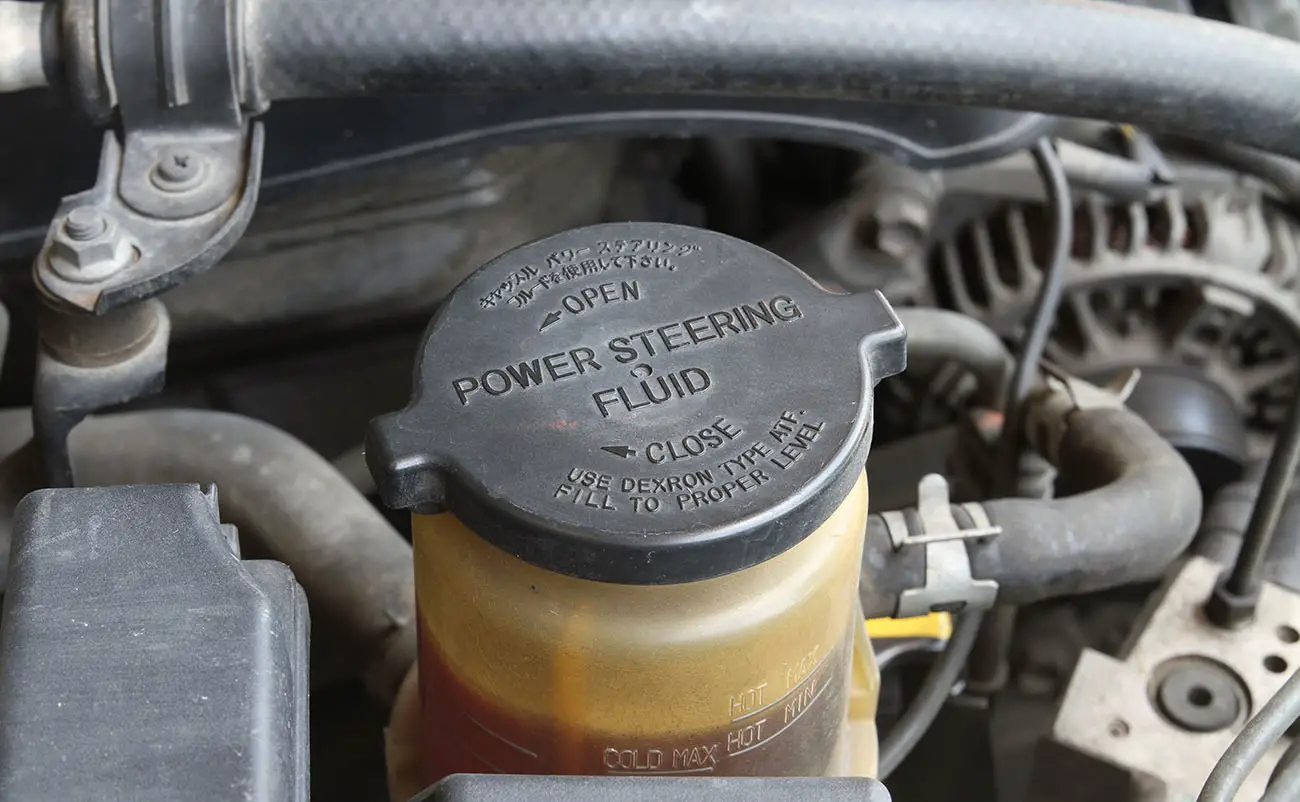Until 1951, vehicles didn’t have a power steering system, and making turns or maneuvers required the use of strength. However, since hydraulic power steering was introduced as ‘Hydraguide’ in Chrysler Imperial, it has evolved to include electric and hybrid systems. Regardless of whichever system your vehicle has, they all do the same thing — amplify the driver’s steering efforts by applying pressure to the wheels.
While the electric system uses an electric motor and requires less maintenance, the hydraulic system is a more complicated system that uses a power steering fluid and requires regular inspection. Therefore, if you have a hydraulic power steering system, it is important to know how to check the fluid level and when to change the fluid. Keep reading as we discuss the function of the power steering fluid, four easy steps to check the fluid level, and when to change the fluid.
Table of Contents
How To Check Your Power Steering Fluid Level

Your power steering fluid requires frequent inspection for early detection and replacement of worn-out fluid. You often get a whining sound when your power steering pump is running on low or contaminated fluid. If you leave the warning unattended, it could damage the pump and other components. Checking the power steering fluid level is an easy task that only requires removing the dipstick from the fluid reservoir. All you have to do is to follow these four easy steps.
#1. Locate The Power Steering Fluid Reservoir
Before you can check the fluid level, you’ll have to locate the power steering fluid reservoir that houses the fluid in the engine bay. The location of the reservoir varies depending on your vehicle’s make and model. Oftentimes, the reservoir is located on the passenger’s side of the car, but it is not unusual to find it on the driver’s side sometimes. The reservoir is usually a white or yellow container covered by a black cap. If you are still having difficulties locating it, you can check your owner’s manual to confirm its location.
#2. Remove The Dipstick And Wipe It Clean
While some may have a level-indicating marking on the side for quick checking of fluid level, most reservoirs usually have a dipstick under the cap. If you have a reservoir with a dipstick, you’ll have to remove the dipstick to check the fluid level. First, remove the dipstick and wipe it clean with a paper towel. The dipstick will have three lines, high, medium, and low — high being the max and low being the minimum. You want to ensure that the fluid level is above the low level but not overfilled.
#3. Reinsert The Dipstick And Check The Fluid Level
After wiping down the dipstick, close the lid and reopen it to get an accurate fluid level reading. The purpose of wiping the dipstick is to get the precise level of the fluid. Not all dipsticks will have high, medium, and low indicators. The labeling may vary depending on your manufacturer and model. You’ll have to check your owner’s manual to be sure of the relevant markings and their interpretation.
#4. Take A Close Look At The Fluid Color
Having sufficient power steering fluid in the reservoir is not enough. You want to closely inspect your car’s power steering fluid to ensure that it is in great shape. The quality of the fluid is proportional to its color. It is meant to be slightly translucent with a pink or amber color. Dark or brown fluid is an indication that the fluid is contaminated and needs to be changed.
What Does Power Steering Fluid Do?

The power steering fluid is crucial in a hydraulic steering system. Without the fluid, steering your vehicle becomes a strenuous task. The fluid is pressurized by the pump which is driven by the crankshaft via a serpentine belt. The pump sends the pressurized fluid through the steering system to help create the pressure on your vehicle’s rack-mounted piston, allowing you to steer your vehicle easily. Hence, the hydraulic fluid amplifies the driver’s steering efforts and allows for smooth steering by transmitting the steering command to the hydraulic piston in the steering rack.
Apart from its primary function of driving hydraulic pressure, the power steering fluid doubles as a lubricant for the moving parts in the system. It also helps prevent corrosion of the power steering pump, piston, and gears to ensure their longevity and smooth operation. The fluid also reduces the operating temperatures of the power steering gear and pump.
Hence, you need to ensure that the power steering fluid is always at the appropriate level to ensure that the system functions effectively. If you notice delayed steering response, grinding, or whining noise when steering your vehicle, it could be due to low or contaminated steering fluid.
When To Change Your Power Steering Fluid
Changing your power steering fluid, otherwise known as flushing, is inevitable. Most manufacturers recommend changing the fluid after 50,000 miles or every two years, depending on whichever comes first.
During operation, the power steering fluid allows for easy steering, lubricates the system, and reduces the system’s operating temperature. The continuous usage of the fluid over an extended period causes the fluid to degrade and gather contaminants. Consequently, the liquid becomes ineffective and needs to be changed.
Having a good understanding of when to change the power steering fluid will help prevent damage to the system’s components. The easiest way of knowing when to change your power steering fluid is by inspecting the fluid color and level. A brown or black colored fluid indicates that it is contaminated and is due for new fluid.
Another indicator of worn steering fluid is steering difficulty. You will notice that you have to exert more effort while steering your vehicle. You may also observe a slow steering response or hear a whining noise whenever you turn the wheel. You want to flush out the old fluid and replace it with fresh fluid to avoid extensive repairs.
Choosing The Proper Power Steering Fluid
While some vehicles use generic standard power steering fluid, others have specific fluid requirements. Using your manufacturer’s recommended power steering fluid will help ensure the system’s smooth running and longevity.
What you want to do first is check your owner’s manual for the specified steering fluid. You want to be sure whether your manufacturer recommends synthetic, non-synthetic, or automatic transmission fluid (ATF) for your system. Regardless, your vehicle’s owner manual will point you in the right direction. Every manufacturer has its specifications for fluid viscosity level, top-off chemical compatibility, and additives content for the system to operate as intended.
Besides the owner’s manual, you can also find your car’s steering fluid specification on the reservoir cap. You want to ensure that you replace the fluid with the manufacturer’s recommendation because incompatible fluid can damage the system and cause issues down the road.
DIY Power Steering Fluid Flush

Over time, you will need to flush the old power steering fluid to get fresh fluid into the system. Flushing the power steering fluid is pretty straightforward, and any DIYer should be able to pull it off with minimal difficulty. The whole procedure should take around two hours. All you need for this procedure is the new power steering fluid, a plastic funnel, a floor jack, a drain pan, a liquid transfer pump, and a set of pliers.
#1. Drain The Reservoir
You want to start by getting the front wheels off the ground by jacking them up. Since you won’t be starting the car, jacking the front wheels allows easy turning of the steering wheel during the procedure. The next step is locating your car’s power steering reservoir and using the liquid transfer pump to drain all the fluid. After emptying all the fluid from the reservoir, turn the steering wheel to push excess fluid back into the reservoir. Now, extract the excess fluid.
#2. Complete The Draining Process By Disconnecting The System’s Return Line
After emptying the reservoir, you want to completely drain the remaining fluid in the system by disconnecting the return line. Since the return line is low pressure, it has low-pressure clamps that can be easily removed. You’ll need a funnel to empty both ends — metal and rubber end — of the return line to avoid making a huge mess. Disconnect the return line and drain the remaining fluid in the system. Turn the steering wheel back and forth to empty the remaining liquid in the system. Add fresh power steering fluid into the reservoir to flush any remnant of the old fluid out of the system. Continue adding fresh fluid until you have clean fluid running out of the return line.
#3. Fill Up The Reservoir And Bleed The System
Once you have clean fluid coming out the return line, you’ve completely drained the system of the old fluid. Reconnect the return line and fasten the clamp. You can now proceed to fill up the reservoir to the recommended level. After filling the reservoir, you want to leave the cap open to bleed out the air that made it into the system during the flushing process. Turn the steering wheel slowly lock to lock to get all the air out of the power steering system. You can now proceed to start your vehicle and inspect the reservoir for bubbles — a sign of air in the system.
Once you’ve entirely bled the system, close the reservoir cap and lower your vehicle. While the engine is running, carefully inspect the return line for signs of leaks, especially at the metal-hose connection point.
The Bottom Line
Power steering fluid amplifies the driver’s steering input by applying pressure to the hydraulic piston, greatly reducing the amount of effort needed to turn your steering wheel. Without the power steering fluid, steering your vehicle will require the strength of a Greek God. Unlike electric power steering, hydraulic power steering is a complex system that cannot function without power steering fluid and requires occasional inspection. You also want to ensure that you use the recommended type of fluid and change worn-out fluids after 50,000 miles or every two years to avoid damaging the pump and other components, whichever comes sooner.
Frequently Asked Questions
Do you check the power steering fluid with the engine on or off?
The most effective way to get an accurate reading of your power steering fluid level is to allow the fluid to warm up. Idle the engine and turn the steering wheel to enable the fluid to warm up. Then, switch off the engine and check the level of your power steering fluid.
Can I drive without the power steering fluid?
Although it is not impossible to drive without the power steering fluid, we don’t recommend driving without it. Apart from helping the driver reduce steering effort, it also helps lubricate the power steering components and prevent them from premature wear. Driving with low or empty fluid in the reservoir puts the system components at risk of damage.
Can I top off my car’s power steering fluid?
Yes, you can top up the reservoir if the fluid is getting low. Pour new fluid until it reaches the recommended fill level, and ensure you use the recommended fluid. However, if you notice dark brown or black fluid, you may want to consider flushing the system as a top-up may be counterproductive.
How often should I check the power steering fluid?
It is advisable to check your power steering fluid at least once a month. Running on low power steering fluid can damage the pump or other components.

